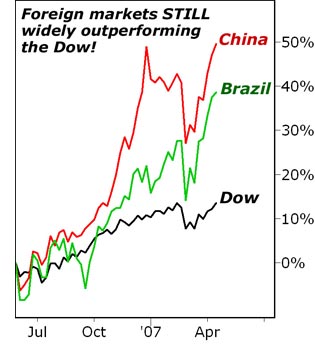The 6 Giants of Global Profits - China, India, Brazil, Canada, Austrailia and Japan
Stock-Markets / Investing Apr 23, 2007 - 12:42 PM GMT
Martin Weiss writes: The U.S. dollar is falling so quickly …
And so many of our favorite investments are moving up so broadly …
I've gathered the wisdom of our entire team this morning to give you a full run-down on the six giants of global profits.
I won't keep you guessing as to who the giants are.
They're China, India, Japan, Brazil, Australia … and Canada.
There is nothing, I repeat nothing, that you do every day that is not connected to, or dependent upon, these six countries.
They make the clothes you wear. They answer the phones when you call customer service.
They supply the gas for your car. They build your car. They make the paste in your toothpaste. Some of them even examine your CT scans instead of your doctor.
Quietly, invisibly, they have penetrated every corner of your daily life … except perhaps one: Your portfolio.
If you do not hold significant investments related to these six global giants, you are already missing out on an opportunity that comes along ( maybe ) once every 100 years.
We've told you how China's stock market, for example, rose 131% last year — nearly ten times more than ours.

We've told you how even Brazil's market, despite a relatively slower economy last year, delivered double the gains of the S&P 500.
And we've explained how fifty-five different foreign stock markets beat the U.S. last year.
Well, now, those markets are soaring even further , still widely outperforming the Dow. China is trumping the U.S. markets. So are Brazil and every other country we've been recommending.
Safety First
Mike Larson warns us that the housing woes in the U.S. are not over. They're getting worse.
And no matter what the profit potential may be overseas, we all feel strongly that your first priority must be capital preservation. That means putting SAFETY first.
That means keeping a good chunk of your core holdings in the most conservative investments you can find.
At the same time, if you're like most investors, the idea of global investing often sounds like a crapshoot. But that's just not true. If you've got all of your money invested in U.S. stocks, you've got all your eggs in one basket. So you could be exposing yourself to more risk.
And you could be missing some of the largest, most sustainable profit opportunities in the world today.
So let's embark on a quick, 10-minute global excursion to review where we've come from and where we're going. It may not be the first time you've taken a tour with us. But no matter what, you're likely to see some refreshingly new sights along the way.
China: "To Get Rich is Glorious"
When Chinese Premiere Deng Xiaoping spoke these words back in 1993, Larry was among the first to let us know.
And indeed, that's when China unleashed an economic force unprecedented in modern history. That single, but pivotal, change in philosophy marked the beginning of China's relentless march to prosperity.
And along the way, we are seeing a series of largely untold economic miracles:
- Chinese consumer spending has recently jumped from virtually zero to nearly $1 trillion.
- There are now over 100 cities in China with a population over 1 million. The U.S. has only nine.
- China currently boasts 1.3 billion consumers. Plus, to stimulate foreign investments, Beijing is pulling out all the stops.
China plans to boost natural gas consumption by as much as 500 percent … invest nearly $4 billion in information technology and infrastructure … expand fiber optic networks … beef up mobile communications capacity … establish digital capable HDTV transmission … and use GPS technology for traffic control.
China is building massive skyscrapers, highways, city expressways, subway lines, and an intra-city light rail.
It's expanding the Beijing airport, improving water, electric, gas, and heating facilities. All across China, the equivalent of a city the size of San Francisco is being built every two weeks. This year alone, Shanghai (with 17 million people) will complete towers with more square footage than all the available space in Manhattan combined.
Even more significant is that China just launched a rural initiative for over 800 million citizens.
It plans to spend over $11 billion a year on rural education, irrigation, and medical services.
And it's investing tens of billions to build 112,000 miles of rural roads — enough to circle the globe four times over.
Gobbling Up Global Natural Resources at a Frightening Rate
Imagine, just imagine, the raw materials and natural resources like cement, asphalt, tar and steel required to feed that kind of growth. That's why consumption of just about every imaginable resource is flying off the charts.
Gold is surging again, nearing the $700 level.
Silver is near the $14 level, within striking distance of last year's highs.
Ditto for copper which has been going nearly straight up since early February.
Aluminum prices are skyrocketing.
Demand for zinc, lead, nickel and tungsten is roaring. Thanks to surging demand from countries like China and India, the price of uranium has tripled in two years. Oil has zoomed from $20 to as high as $70 a barrel in three years.
Look at platinum — close to $1,300 an ounce ! And never forget uranium, which just smashed clean through the $100 per pound barrier!
Even the price of water is rising rapidly around the world.
The Relentless Rise of India: "It's Like China 15 or 20 Years Ago."
Those are the words of a renowned emerging-markets investor that appeared in a recent issue of Time magazine. But that's just a tiny glimpse of India's almost unlimited potential:
- India is currently home to more than 1 billion people and projected to surpass China as the most populous country on Earth by 2015.
- India's economy is growing 8 percent a year — the second fastest rate in the world.
- The Indian stock market has tripled in three years — creating a record number of billionaires. One reason: Foreign investors have poured $30 billion into India's stock market in 36 months.
Just like China, India needs massive amounts of natural resources and commodities to feed its booming economy.
And this is not just a passing trend. It's an economic appetite that could last for a long time. But where will China and India find the commodities, natural resources, and consumer products to feed their unbridled expansion?
A "Back Door" to Asia: Brazil!

I recently returned from Brazil. We were honoring Elisabeth's mother for her upcoming 90th birthday. At the reservoir on our farm, her grandchildren and even their dog join the festivities.
Ever since Luiz Inácio Lula da Silva ("Lula") was elected Brazil's president five years ago, she's been saying he'd wreck the economy.
Lula has done precisely the opposite.
He's implemented the most disciplined fiscal and monetary policy the country has seen in half a century.
He has boosted Brazil's currency by 69% since he took office in January 2003. He has increased the trade surplus by 225% from $14.1 billion to $45.8 billion. And he has paid off 100% of Brazil's debts to the International Monetary Fund.
To achieve all that, however, Lula had to pay a stiff price: Spartan government spending, sky-high interest rates … and, consequently, a relatively slow economy last year.
So it's only now, in his second term which began almost four months ago, that he feels he's got a firm enough financial foundation in place to go for the real prize: Big growth.
With that goal in mind, the Bank of Brazil (the equivalent to our Fed) has already slashed its benchmark interest rate 14 times, to the lowest level in recent history.
And sure enough, the economy is responding:
Retail sales have jumped 8.5%. Capital goods production jumped 18%. And Brazil's key stock index, the Bovespa, which rose 32.9% last year, is making new highs again.
In just four years, Brazil's president, Luiz Inácio Lula da Silva, has transformed the Brazilian economy and forged monumental deals with China.
Brazil's trade balance has gone from an $8 billion deficit to a $46 billion surplus. Just recently, Brazil's state-owned oil company has inked a deal to sell China 12 million barrels of crude oil.
How do you get all that oil out of Brazil when its infrastructure is not up to par? No problem for China.
They've offered many billions to improve Brazil's port and railway infrastructure — so they can extract natural resources more efficiently. China is also building the world's second largest dam in the Brazilian Amazon.
And energy from that dam will power mines that send raw material to … China. Brazil's natural resources are equivalent to those of the U.S. and Canada combined. But even those resources alone can't feed the needs of China, India, and all of Asia.
So these resource-gobbling giants are looking elsewhere too.
Canada: The Strongest, Most Stable Natural Resource Nation in the World

Sean Brodrick tells us that, unlike emerging nations, Canada has all the technology and expertise it needs to exploit its vast resources.
Even more important, Canada has modern deep-water ports on both the Atlantic and Pacific coasts — giving it easy access to both European and Asian markets.
Best of all, Canada is sitting on massive deposits of gold, uranium, coal, oil and other vital resources.
And they're already cashing in. Canada recently recorded its fifth-best trade surplus in history.
The reason? China.
Chinese importers are buying all the raw materials that Canada can sell them. That, plus a boom in mining projects and fattening margins, helps explain why the TSX-Venture exchange (Canada's small-cap market) has outperformed the S&P 500 by 153% over the past five years. Meanwhile …
- China has bought one of Canada's largest oil companies.
- China has blanketed the country with a vast network of scouts (armed with truckloads of money) to scoop up coal mines, oil sand fields, natural gas pipelines and metals.
Remember: Canada is the most modern and technologically advanced of the world's large natural resource nations.
Exploration spending for mining in British Columbia alone hit a record high of $230 million dollars in 2006, and should keep ramping up in 2007.
A New Chinese "Gold" Rush in Australia?
In the 1800s, Chinese miners flocked to Australia for the great gold rush. Today, it's happening again.
Only the Chinese aren't looking for gold; they're after uranium. And they're not coming with picks and shovels.
They're coming with mountains of money. Why? Because Australia happens to sit on the world's largest known deposits of uranium — with more reserves than the United States, Canada, Russia and Brazil combined. And with more than 900 new nuclear plants now being planned, the hunger for uranium is just beginning.
Australia's abundant natural resources — including iron ore, nickel, coal, uranium, and more — are in such huge demand in nearby Asia, it's no surprise then that …
- Australia's economy is now in its sixteenth consecutive year of expansion.
- Job growth has been the strongest in 17 years, dropping the jobless rate to the lowest level in more than three decades! Result: Consumer spending is growing and consumer confidence recently hit a 19-month high.
- There's no better indicator of a country's future than its currency, and the Aussie dollar recently reached its highest level since 1996.
Japan: The Sun is Rising Again
Japan is now enjoying its longest, non-stop, sustained expansion since World War II.
Automakers are soaring. Banks are thriving. Unemployment just hit a record low.
And the stock market has doubled in 24 months. So what's the mega-force behind Japan's remarkable recovery? You guessed it — China.
Japan's trade with China jumped to $189 billion last year, the seventh straight annual record. This year, it should easily top $200 billion.
Look. Just when most people were giving up on Japan a few years ago, the country was cleaning up its balance sheet and starting to capitalize on China's economic boom.
At the same time, Japan is also solidifying trade and security links with Australia. It's currently the biggest buyer of that country's coal, natural gas, oil, and agricultural goods. And if the two countries hammer out a free trade agreement, both economies will get an additional boost.

Tony Sagami, who's recently revisited his native Japan, puts it this way:
"Everybody I talked to — from the fish vendors at Tsukiji market to the Shiseido clerks at luxury Takashimaya department store — says their companies are making more money and they're much more optimistic about the future.
"But investors aren't quite as bullish. So valuations on Japanese stocks are still among the lowest in the world."
This Worldwide Growth and Expansion Represents the Greatest Wealth-Building Opportunity in the Last 100 Years.
I hope I've managed to communicate the colossal magnitude of the expansion that's now happening. I also hope you understand that opportunities like these come along maybe once every hundred years. The time is now.
You can stand pat with a narrow-minded investment strategy that focuses on the USA. Or you can intelligently diversify with these exploding markets and watch your portfolio multiply.
How To Invest Overseas
Years ago, investing in foreign stocks was cumbersome. You had to start with substantial sums. You had to open special brokerage accounts in Honk Kong, London or elsewhere. And you often had to pay very substantial commissions. Today, it's far more convenient because …
- You can buy American Depository Receipts, or ADRs, a certificate issued by a U.S. institution representing a specific number of shares of a foreign stock. Favor ADRs that are liquid, trading hundreds of thousands of shares daily on major U.S. exchanges like the NYSE.
- You can buy foreign stocks through a U.S. broker with a strong international desk such as Euro-Pacific Capital or Schwab. And most convenient of all …
- You can buy exchange traded funds (ETFs) that invest in overseas stocks for you. There are actively traded ETFs for China (FXI) … Brazil (EWZ) … Singapore (EWS) … Japan (EWJ) … and many, many more.
But never forget: Don't overinvest. Allocate your money prudently. Stay on top of it regularly. And do your best to wait for normal corrections before adding new funds.
Good luck and God bless!
By Martin Weiss
This investment news is brought to you by Money and Markets. Money and Markets is a free daily investment newsletter from Martin D. Weiss and Weiss Research analysts offering the latest investing news and financial insights for the stock market, including tips and advice on investing in gold, energy and oil. Dr. Weiss is a leader in the fields of investing, interest rates, financial safety and economic forecasting. To view archives or subscribe, visit http://www.MoneyandMarkets.com
© 2005-2022 http://www.MarketOracle.co.uk - The Market Oracle is a FREE Daily Financial Markets Analysis & Forecasting online publication.



